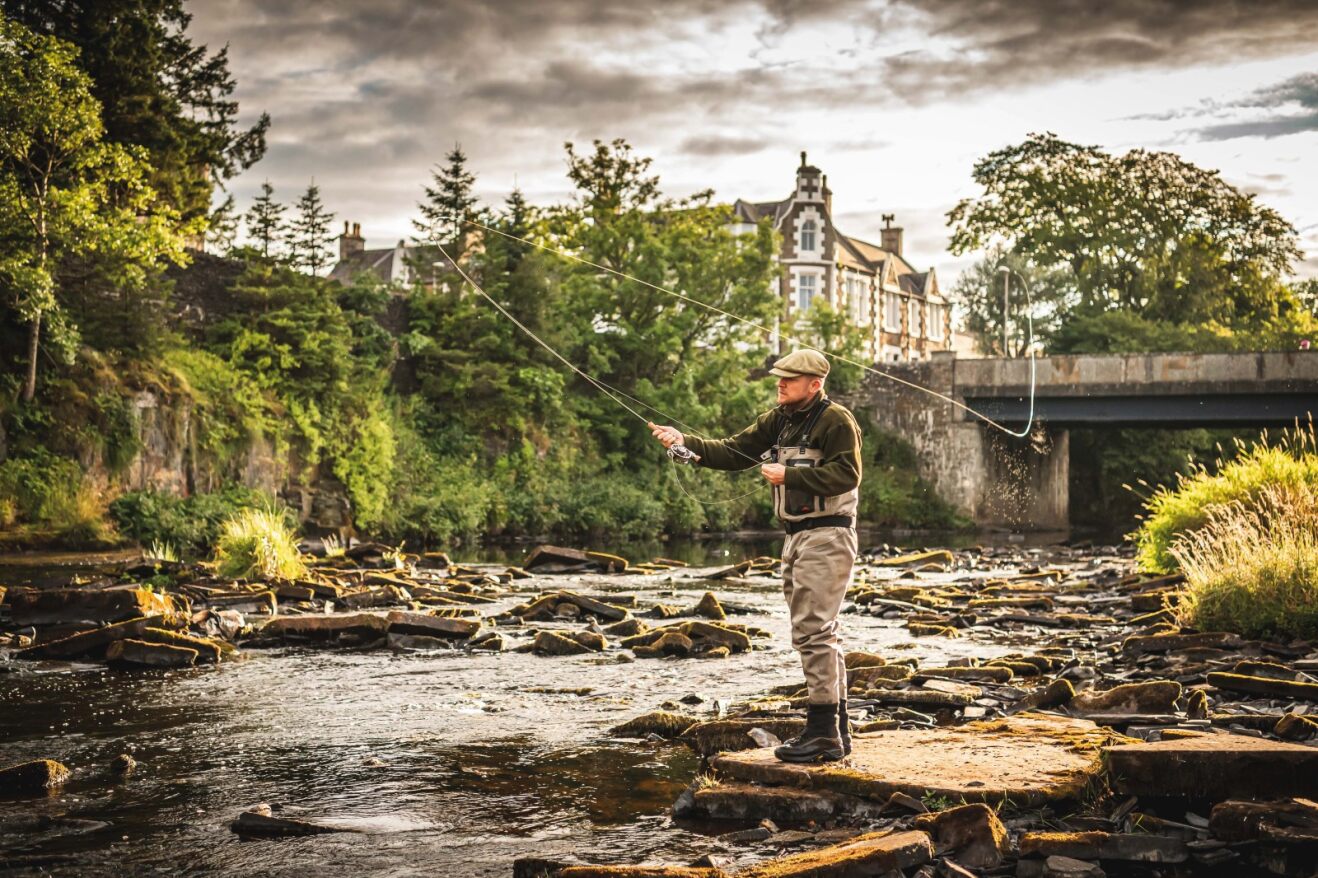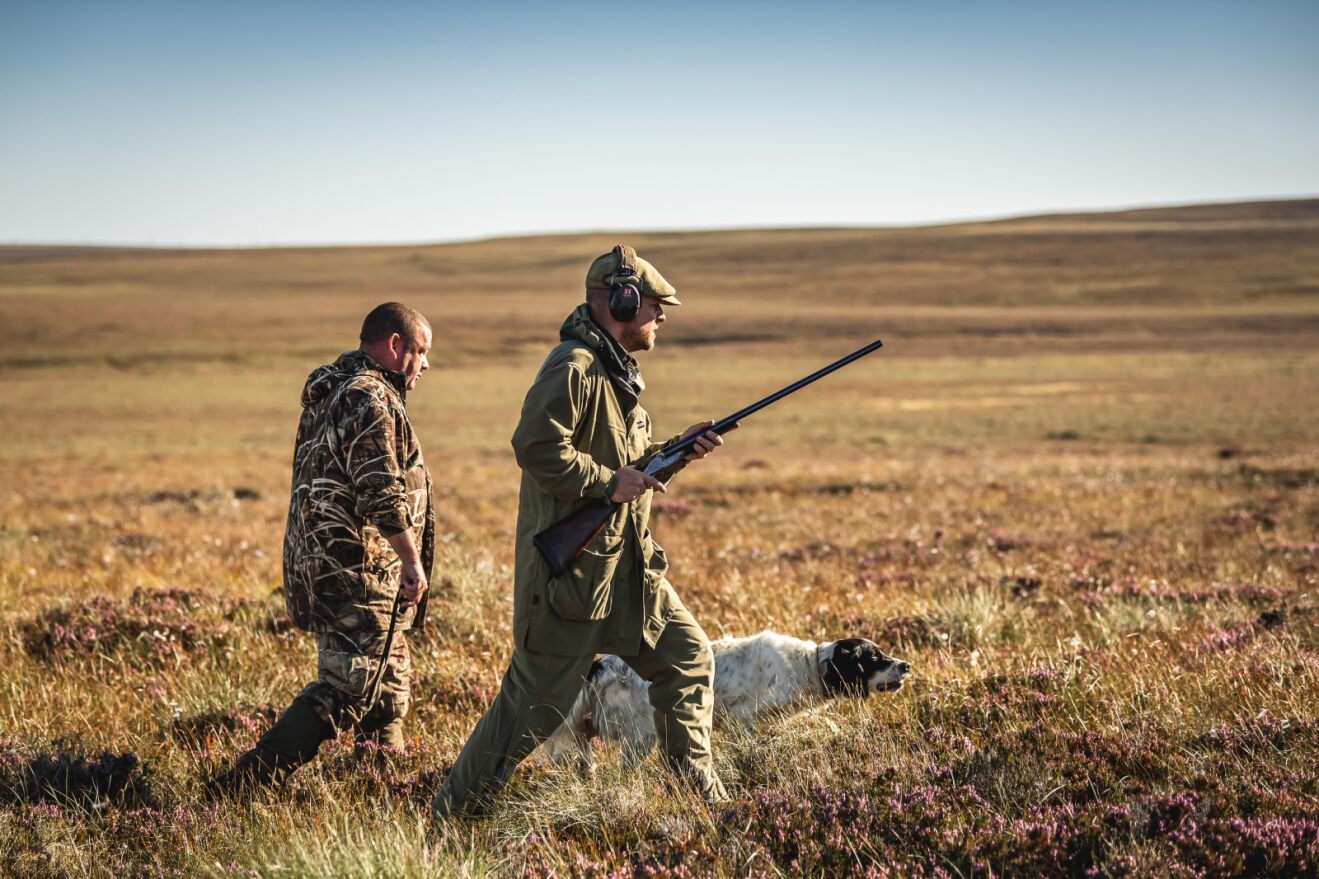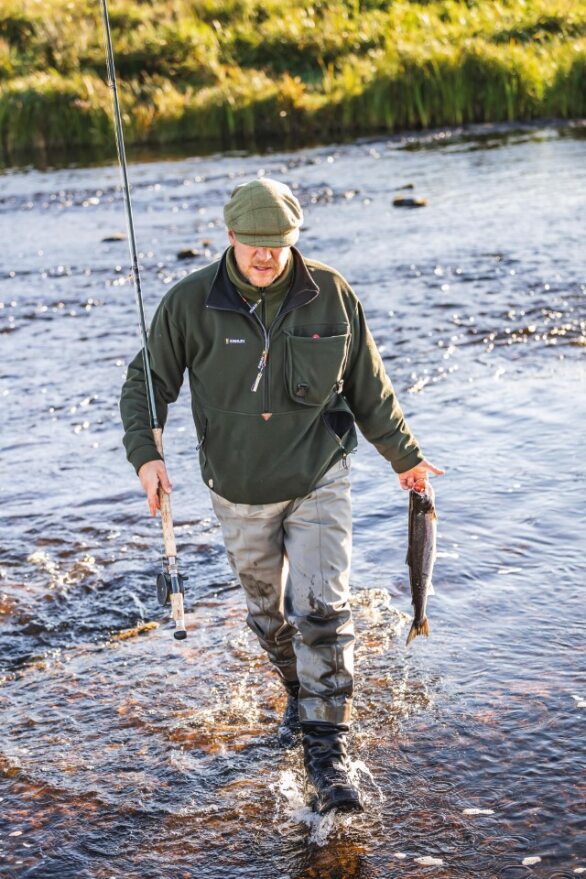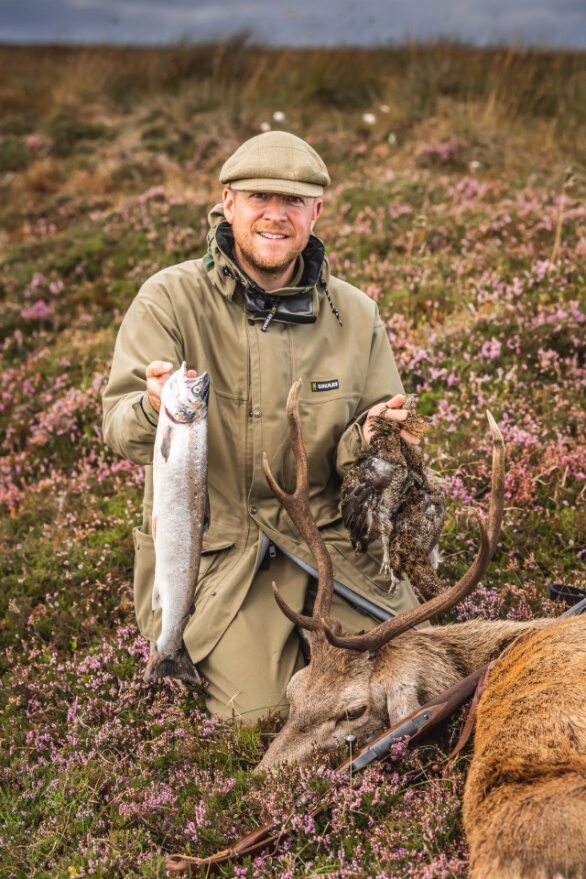Looking back on my life, John Buchan’s tale John Macnab has been omnipresent. But until I penned this piece I had not quite appreciated just how much the story had touched my life. I first read a tatty Penguin edition as a young boy and have since read it twice more as an adult. Each time I have devoured the dog-eared pages, finishing it in just a few hours. The words never fail to capture my imagination and the characters stay with me long after I have turned the last page.
The last 10 years in particular – since my first attempt at the Macnab Challenge in Argyll – have been peppered with its narrative. When I married my lovely Selena in 2011, she surprised me with a very special wedding gift – a leather-bound first edition – that had taken her two years to source. It now sits front and centre on my office bookcase among other fine sporting literature. After three failed attempts at the Macnab, in 2014 we moved from Sussex to the Scottish Borders, partly so that I could be closer to the River Tweed to fish for salmon more regularly and master a double-handed fly rod. The vast majority of successful Macnabs start with the fish and I knew I needed to boost my chances.
There are more examples of Buchan’s influence. More recently we renovated our home and installed a hidden bookcase door in the snug. To gain entry, a copy of John Macnab must be partly pulled from the shelf, completing a successful challenge in itself. When we relocated the headquarters of Fieldsports Journal to Edinburgh, we renamed the building Macnab House. So you see, I am a bit taken by what is, in my view, the ultimate in personal sporting challenges.
In all there are 11 chapters to my Macnab story, each ending in defeat – bar, of course, the last. Each as important as the others, every chapter galvanised my resolve to conclude my tale. It’s been about patience, something I am little known for; bloody mindedness, more part of my character; and determination. My story culminated in a grand finale when the stars finally aligned in Caithness, about as far north as one can seek sport in mainland Great Britain. I am still on a massive high; it feels surreal to say that I have finally succeeded. It was my mission for a little over a decade – and it’s now done.
When trying to explain the Macnab to non-shooting friends or those living outside the UK, I normally use cricket as an analogy as it is equally eccentric and strange to the unaccustomed. Why would one be so motivated to carry out this bizarre challenge of catching a salmon on the fly, shooting a brace of grouse and taking a stag – all between dawn and dusk? I think cricket – also inherently British – has many strange idiosyncrasies such as the Ashes series lasting over five, five-day matches, and the absurd Duckworth-Lewis method for calculating a target score if rain interrupts play. There is quite a nice parallel between the two. To me, the Macnab was my own Ashes series.
 Perspective and respect
Perspective and respect
I owe a debt of gratitude to the rivers that vanquished my chances over the years. They gave me perspective and ultimate respect for Atlantic salmon, the wildest and trickiest of creatures in the British Isles. The Tilt,
the Findhorn, the Orchy (an awkward sod of a river) and the mighty Tay. I was finally gifted my chance by the Thurso, the most northerly salmon river in mainland UK.
However, the final attempt was by no means straightforward.
As I said, it is customary to start with the fish, being the most fickle of the components in the Macnab. The one time I chose to reorder the elements I had a royal stag grassed and gralloched by 10am and a brace of ptarmigan (which elevate the challenge and count as a grouse species) in hand by midday. But alas, no lie in the Orchy would give up its treasure, so darkness fell and with it my hopes for that year. Salt was applied liberally to my open wound the following morning when my most unsympathetic of friends, Gary Tate, hooked a 12lb hen fish from the same pool I had finished at the night before.
I have now finally succeeded in my quest. The water conditions of the Thurso had been tragic for salmon fishing. There hadn’t been any significant rainfall for a couple of months, so the water was very low and far from ideal. However, the river was stuffed full of fish, albeit stale, bored and uninterested in flies, having been stuck for weeks waiting to run at the first drop of rain and seeing everything thrown at them day after day. It was a seemingly hopeless situation.
The first day I was on the river by 6am, I knew if it was going to happen it would be early in the short window of activity when the fish take up prime pool positions for the day. As advised by the keeper, I had until midday to land one, otherwise the attempt was over for the day as there wouldn’t be enough time for the grouse and stag. I fished hard for six hours without a break. The pools were boiling with activity but nothing gave me a look. Accepting the inevitable we drew stumps. In the evening, as direct sun left water, we fished again – just for fun – and incredibly I caught a bloody salmon. Any day you hook a salmon is a good one, but this felt bittersweet. I needed to catch the fish at 7am not 7pm!

Hope and optimism
The next morning, with renewed hope that these fish were catchable, we changed our beat to lower pools towards the sea. It was stacked with fish – even more than the day before. It was narrow like an Icelandic river, the sun was rising and there were salmon splashing everywhere, taunting me. With renewed optimism and a pat on the back from Jim Cameron, the ghillie, I set about trying again. Within 20 minutes it happened; I hooked a salmon. Then, after just four seconds, it was off. I don’t think I have ever used bluer language on a riverbank. Extremely unsportsmanlike. I was shaking even more than the time I shot a Cape buffalo, such was the adrenaline coursing through my frustrated arteries. I had nearly done it, but again it had got the better of me. I was crushed and behaving rather like my three-year-old daughter, Skye – bottom lip out and irrational.
Jim had words, told me to pull myself together, go to the top pool and use his traditional fly – a more conventional approach than what I thought were the clever Iceland tactics I had been deploying. At 8am on the dot, swinging a classic dressed Willie Gunn double over the neck of the pool, the line tightened, pulled, and my antique 1910 Hardy Perfect reel sung into action – if you know that sound, you’ll know why I fish with it. I gingerly played, palmed and landed a fresh cock grilse of four glorious pounds that must have snuck into the pool under cover of darkness despite the low water.
The Macnab was on! For those questioning my decision to take the fish, the Thurso enjoys a sustainable surplus of salmon with, at the angler’s discretion, a two-fish limit. This bar of silver fitted my ethical compass and was indeed a perfect table fish.

I was totally composed and in the zone. Jim hadn’t been hugged by an angler in the 16 years he has guided on the Thurso but I think he understood. After my celebration I felt ahead of the clock with most of a full day ahead. I jumped into the Discovery and set off to the headwaters of the Thurso on Ulbster estates.
The specific area was Dalnawillan and Rumsdale estate, about 35 miles from John O’Groats. It is an area known as the Flow Country – a large, rolling expanse of peatland and wetlands, flatter than much of Scotland and making stalking more of an art, with less dead ground to cover an approach. It is the largest expanse of blanket bog in Europe and one of the UK’s most remote wilderness areas.
Mark Pirie, a veteran stalker and keeper, decided we’d first attempt the grouse.
They are fewer in number this far north, so this was by no means the easy bit. Driving through a ford, decamping and then setting off, I was shooting over an experienced English setter called Flame. Half an hour of yomping through tussocks and heather passed, then he was on point. The covey flushed and my reflexes lifted an 1895 Rigby Rising Bite 12-bore to my shoulder. I cleanly shot the first, but with nerves getting the better of my gun mount I missed the second. Mercifully, not long after Flame winded another covey and, feeling more composed for the shot, I pulled the front trigger to fire the right barrel. It was all I needed to bag my brace. It was then 10am and things were looking promising. Now for the stag.
The ground to the stags was flat, so we had a long way to go in the Argo following the Rumsdale burn, a small tributary of the Thurso. Once we had identified a group of shootable animals, we stalked on foot for an hour then crawled slowly using what cover the peat hags and small burn gave us. We glassed hard antler in some rushes ahead of us and the head looked old. Perfect. The stag was bedded up and in no hurry to move. At 140yd we could see his head clearly, moving occasionally from side to side, but he was enjoying the sun and would not stand.
I had to wait a gruelling 90 minutes, lying prone. I imagined the shot over and over until it was finally on and all that stood between me and the Macnab. He rose and faced us, offering a terrible shot, then turned, quartering away. I split the light between his front legs with the vertical post of the crosshairs, came half way up the body and squeezed. The .275 Rigby dropped this majestic old beast a few yards from the burn. It was pleasing to think my Macnab had concluded at the headwaters of the river in which I had caught my salmon eight hours and nine minutes earlier. It felt as though the river was a thread running through all three elements of the day.
I feel that every day I have spent in the field with rod, shotgun or rifle since I first tried to complete the Macnab has been one day closer to doing it. I am a much better fisherman, shot and marksman than I was on my first attempt. It has been a celebration of the wildest and most enjoyable sport on offer in the UK and has been a wonderful journey. I have relished a decade of trying.
That evening, when I arrived jubilant back at the Ulbster Arms, the staff and other guests gave me a round of applause as I walked through the door of the restaurant, smelling faintly of gralloch and still clothed from the hill. It was – and still is – absolutely brilliant. I would like to thank every ghillie, stalker and keeper who has been part of this story, without whose good humour and skill it would not have been possible, and Selena for her patience and encouragement with my obsession to get it done. Every sportsman understands the magnitude of the accomplishment. There is no trophy or tie at the end of this challenge – just personal satisfaction, bragging rights and a fine dinner party anecdote.

With thanks to Lord Thurso for the privilege of completing this challenge at Ulbster Estates.